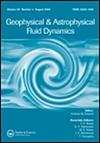准地转湍流降水中的大气水谱
IF 1.1
4区 地球科学
Q3 ASTRONOMY & ASTROPHYSICS
Geophysical and Astrophysical Fluid Dynamics
Pub Date : 2020-11-01
DOI:10.1080/03091929.2019.1692205
引用次数: 12
摘要
大气水具有复杂的行为,部分是由于降水的影响。因此,解释水的性质是具有挑战性的,例如其方差的尺度依赖性,为此已经在观测数据中确定了一系列光谱指数。在这里,一个沉淀的准地转(PQG)模型被探索作为一个可能的原型,有助于理解水的光谱,在理想的设置。在数值模拟中研究了地转湍流,其中包括降水以探索其对水谱的影响,但忽略了相位变化以允许相应的理论分析。根据降雨速度参数,水谱指数的范围约为- 1.4至- 5,这表明降水对水谱有重大影响。的大值和小值的渐近分析解释了该范围的极限值。为了获得对该模型的理论理解,一个关键的观察结果是,水可以写成另外两种示踪剂(等效势温和湿润变量M)的线性组合,这两种示踪剂本身具有理论上可处理的光谱。这另外两种示踪剂与PQG方程的不同模式相关联——涡旋模式和湿润模式——这里的分析强调了波浪或模式分解对理解饱和区域水的有用性。本文章由计算机程序翻译,如有差异,请以英文原文为准。
Spectra of atmospheric water in precipitating quasi-geostrophic turbulence
Atmospheric water has a complex behaviour partly due to the influence of precipitation. Consequently, it is challenging to explain properties of water such as the scale-dependence of its variance, for which a range of spectral exponents has been identified in observational data. Here, a precipitating quasi-geostrophic (PQG) model is explored as a possible prototype for contributing to understanding of water spectra, in an idealised setting. Geostrophic turbulence is examined in numerical simulations, where precipitation is included to explore its effect on the water spectrum, but where phase changes are neglected to allow corresponding theoretical analysis. The water spectral exponent is seen to range from approximately −1.4 to approximately −5 depending on the rainfall speed parameter, , which indicates a significant influence of precipitation on the water spectrum. The limiting values of this range are explained through asymptotic analyses for large and small values of . To obtain this theoretical understanding of the model, a key observation is that water can be written as a linear combination of two other tracers (equivalent potential temperature and a moist variable M), which themselves have theoretically tractable spectra. These two other tracers are linked to distinct modes of the PQG equations–the vortical mode and a moist mode – and the analysis here highlights the usefulness of wave or mode decompositions for understanding water in a saturated domain.
求助全文
通过发布文献求助,成功后即可免费获取论文全文。
去求助
来源期刊

Geophysical and Astrophysical Fluid Dynamics
地学天文-地球化学与地球物理
CiteScore
3.10
自引率
0.00%
发文量
14
审稿时长
>12 weeks
期刊介绍:
Geophysical and Astrophysical Fluid Dynamics exists for the publication of original research papers and short communications, occasional survey articles and conference reports on the fluid mechanics of the earth and planets, including oceans, atmospheres and interiors, and the fluid mechanics of the sun, stars and other astrophysical objects.
In addition, their magnetohydrodynamic behaviours are investigated. Experimental, theoretical and numerical studies of rotating, stratified and convecting fluids of general interest to geophysicists and astrophysicists appear. Properly interpreted observational results are also published.
 求助内容:
求助内容: 应助结果提醒方式:
应助结果提醒方式:


